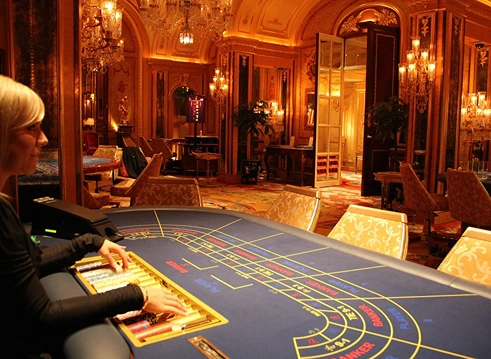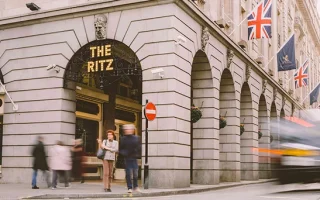The Ritz Club: London’s Pinnacle of Exclusive Gaming
Nestled beneath the gilded grandeur of The Ritz London hotel at 150 Piccadilly, The Ritz Club opened its doors in 1978 as a subterranean jewel of opulence, transforming the hotel’s former ballroom into a casino that swiftly became a legend among London’s elite gambling circles. Conceived by Mecca Sportsman and Pleasurama, and later acquired by London Clubs International in 1998 under the banner of The Ritz Hotel Casino Ltd., this private members’ club was a sanctuary for high rollers and celebrities, its 18,000-square-foot space adorned with 6,000 sheets of gold leaf, Bohemian crystal chandeliers, and a ceiling painted with a twilight sky. With a £1,000 lifetime membership fee and a rigorous vetting process, it offered an intimate gaming floor of just 15 tables—no slots, only classics like roulette, blackjack, baccarat, and three-card poker—ensuring an atmosphere of exclusivity and sophistication that drew the likes of Johnny Depp, Al Pacino, and Bill Clinton until its permanent closure in May 2020.
The Ritz Club’s physical allure was rooted in its storied past and meticulous restoration, turning a space once known as the Ritz Bar and Grill (and briefly a WWII nightclub, La Popote) into a gaming haven that echoed the Louis XVI elegance of its parent hotel. Its launch capitalized on Britain’s 1968 Gaming Act, offering a legal loophole for luxury gambling in a city where such venues were scarce, and its basement location beneath one of London’s most iconic hotels amplified its mystique. Beyond gaming, it boasted a world-class restaurant with international cuisine—Thai, Indian, Chinese, and Middle Eastern dishes—and a bar famed for its fine whiskies and champagnes, making it a social hub for the rich and famous. This physical casino legend thrived on its reputation as a discreet retreat, its closure during the 2020 pandemic marking the end of an era for a venue that had not turned a profit since 2016, leaving behind a legacy of glamour and a £780,000 debt to its final gamblers.
A Gaming Salon of Unrivaled Elegance
The Ritz Club’s gaming experience was a masterclass in understated luxury, its 15 tables spread across the main salon and three private rooms—the Salle Privé, Carmen, and Amber—offering an intimate contrast to the sprawling floors of modern casinos. European roulette wheels spun alongside blackjack, baccarat, and three-card poker tables, with minimum bets starting at £5 for roulette and £25 for others, while the Salon Privé welcomed stakes in the tens of thousands for invited VIPs. The absence of slot machines was deliberate, preserving an old-world charm where skilled croupiers and personal service reigned supreme, all under a dress code mandating jackets after 7 p.m. This physical space, opened 24/7 to members and hotel guests, was less about volume and more about prestige, its gold-leafed walls and mirrored ceilings reflecting a bygone era of gambling sophistication that captivated a global clientele.

Beyond the tables, The Ritz Club wove a tapestry of indulgence that extended its appeal beyond mere chance. The restaurant, overlooking Green Park through velvet-curtained windows, served award-winning dishes crafted from seasonal produce, earning accolades from the Royal Academy of Culinary Arts, while the bar’s whisky selection—rumored to have won over Johnny Depp—added a layer of allure. Private gaming salons offered seclusion for the ultra-wealthy, their discreet entrances a nod to the club’s clientele of business tycoons and Hollywood stars, while events like poker tournaments and album launches (Dame Shirley Bassey’s The Performance in 2009) kept it culturally vibrant. This physical casino legend thrived on its ability to fuse gaming with a lifestyle of extravagance, its closure in 2020—prompted by years of losses (£8.9 million pre-tax in 2018) and a sale to Hard Rock International of its casino license—leaving a void in London’s high-society gambling scene.
- Gaming Floor: 18,000 square feet with 15 tables across four areas.
- Games Offered: European roulette, blackjack, baccarat, three-card poker.
- Membership: £1,000 lifetime fee, plus vetting for exclusivity.
- Dining: Award-winning restaurant with international cuisine.
- Location: Basement of The Ritz London, 150 Piccadilly, Mayfair.
The Ritz Club by the Numbers
| Feature | Details | Rating (Out of 5) |
|---|---|---|
| Gaming Variety | 15 tables, no slots, elite focus | 4.5 |
| Ambiance & Design | Gold-leaf decor, Louis XVI style | 5.0 |
| Entertainment Value | Private events, bar, dining | 4.6 |
| Exclusivity | Members-only, £1,000 fee | 4.8 |
| Historical Significance | 1978-2020, celebrity hotspot | 4.9 |
The gaming variety earns a strong rating for its curated elegance, though the lack of slots and limited table count (five roulette, five blackjack, four baccarat, one poker) caps its breadth compared to larger casinos. Its ambiance is flawless—6,000 gold leaves and a chandeliered ballroom set a standard few can match—while entertainment value shines with private salons and cultural moments, though it lacked the scale of live shows found elsewhere. Exclusivity is near-perfect, its £1,000 fee and vetting process ensuring a rarefied crowd, though this restricted accessibility. Historically, it’s a titan—its 42-year run shaped London’s luxury gambling scene, its closure leaving £780,000 in unpaid jackpots as a bittersweet footnote.
The Ritz Club’s physical journey reflects a rollercoaster of ambition and adaptation, from its 1978 opening with Trafalgar House’s lease to its 1998 rebirth under London Clubs, restoring the basement’s 1906 splendor after years as a WWII dugout-themed nightclub. Its location beneath The Ritz London, steps from Green Park and Piccadilly Circus tube stations, offered unmatched prestige, though its small size—born from a ballroom’s footprint—limited expansion. Losses mounted after 2016 (£11.3 million in 2017, £8.9 million in 2018), driven by tighter regulations and fewer Middle Eastern high rollers, prompting the Barclay brothers to inject £8 million in 2020 before selling the hotel to a Qatari investor for £750 million. The casino license’s transfer to Hard Rock International sealed its fate, ending a physical legend that couldn’t outrun economic tides.
For its members, The Ritz Club was a tailored haven—limousine service whisked them to Piccadilly, where attentive staff and private rooms catered to every whim, from high-stakes baccarat to a cigar on the smoking terrace. The Ritz Club Membership offered perks like complimentary entry for hotel guests and event access, though its closure left gamblers high and dry, with Hard Rock’s brash style unlikely to replicate its refined charm. As a physical casino, it was a jewel box of elegance, its intimacy a double-edged sword—beloved by tycoons, but too niche to thrive in a shifting market. The Ritz Club’s legacy endures in memory, a real-world icon of London’s gilded gambling past.
- Private Rooms: Salle Privé, Carmen, and Amber for VIP gaming.
- Bar: Renowned for fine whiskies and champagnes.
- Restaurant: Michelin-caliber international fare overlooking Green Park.
- Dress Code: Smart-casual, jackets required after 7 p.m.
- Transport: Limousine service, near Green Park and Piccadilly Circus tubes.
The Ritz Club’s legend is as much about its cultural cachet as its physical opulence, a venue where history and Hollywood converged beneath Piccadilly’s bustle. Its 1978 debut filled a void in London’s gaming scene, its ballroom-turned-casino hosting the Queen Mother’s trophy presentations for the Ritz Club Trophy Stakes at Ascot and Dame Shirley Bassey’s album launch, while its amber-hued rooms starred in Bond films and drew Johnny Depp’s praise. The club’s 2020 closure—announced via email to devastated members—came after years of financial strain, with the Barclays’ £8 million lifeline in January 2020 unable to stem losses or halt the hotel’s sale to Abdulhadi Mana Al-Hajri. Its 18,000-square-foot footprint, though modest, was a stage for the world’s elite, its £780,000 debt to players a final sting in a glittering saga.
The physical experience at The Ritz Club was a sensory plunge—descending from The Ritz London’s marble lobby into a gold-drenched underworld felt like stepping into a 1920s fantasy, the air heavy with whisky fumes and the clink of chips. The main salon’s mirrored ceilings doubled the dazzle, while private rooms offered hushed exclusivity, their velvet curtains shielding millionaires from prying eyes. Dining was a triumph—chef Kristian Kurn’s Thai curries and dim sum rivaled the gaming thrill—yet service could falter under peak demand, and the lack of slots irked some X users craving modern variety. Still, these quibbles paled against a backdrop of unparalleled refinement, its closure mourned as “a real shame” by members who lost a peerless gambling sanctuary.
As London’s casino landscape shifts—Hard Rock eyeing a louder, brasher venue with The Ritz’s license—Sun City endures, its 46th anniversary in 2025 promising new dining and a Palace refresh. Its revenue, once R2 billion yearly, supports 4,000 jobs and funds Sun International’s expansion, while its bushveld setting—near a volcanic crater—adds primal allure. Sun City Casino endures as a physical legend, its faux ruins and real legacy a testament to what’s possible when imagination meets opportunity. For those crossing its threshold, it’s not just a casino—it’s a real-world epic, a South African saga of glamour, grit, and unapologetic excess.

